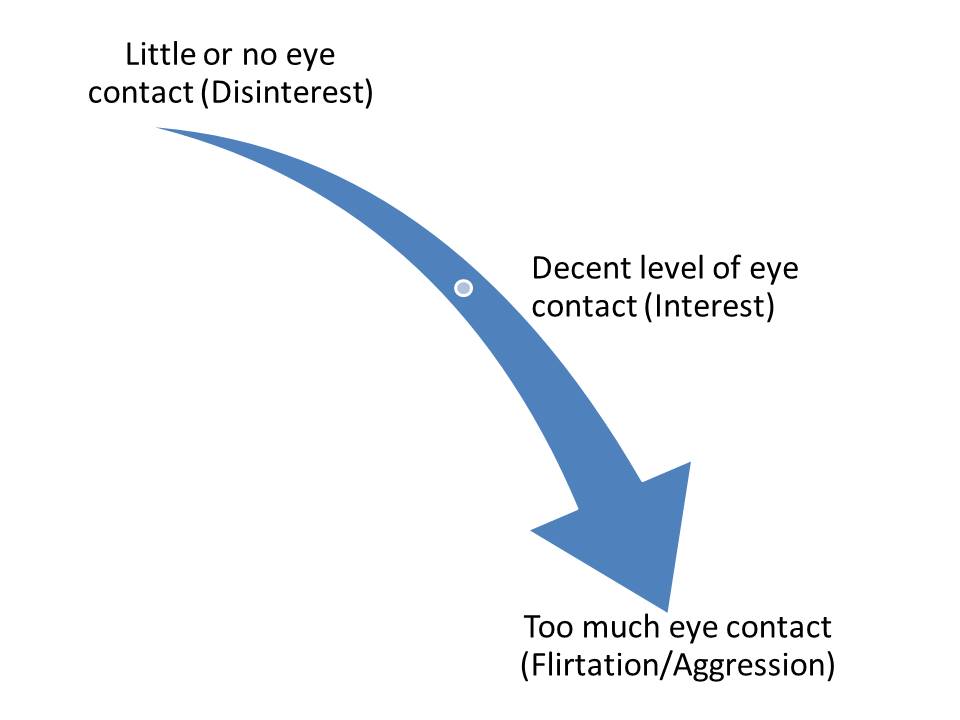In body language, the rule of thumb is that our body turns to where we want to go and what we want to engage with. The same applies to the eyes, which are a body part, after all. Generally, we turn our eyes to where our body wants to go and what our minds want to engage with.
Hence, when a person avoids eye contact, it means they don’t want to engage with what’s in front of them or that they want to engage with something else. This ‘desire for a lack of engagement’ with an object is the core reason behind almost all the reasons for avoiding eye contact.

When you notice someone avoiding eye contact, think:
“Okay, this person wants to disengage. Why?”
It’s tempting to conclude they don’t like you. So I want you to focus on the ‘desire for disengagement’ first and then explore the specific reason for that desire.
People like eye contact
Being the social species that humans are, they like it when others make eye contact with them. It makes them feel connected and included. In contrast, avoiding eye contact makes them feel you’re excluding them.1Wirth, J. H., Sacco, D. F., Hugenberg, K., & Williams, K. D. (2010). Eye gaze as relational evaluation: Averted eye gaze leads to feelings of ostracism and relational devaluation. Personality and Social Psychology Bulletin, 36(7), 869-882.
When you make eye contact with someone, you’re communicating:
“You’re important to me. I want to engage with you”.
The desire to feel important, valued, and wanted in humans is strong.
Studies show that those who maintain eye contact are seen as attractive, interested, competent, socially skilled, having good mental health, credible and dominant.2Kleinke, C. L. (1986). Gaze and eye contact: a research review. Psychological bulletin, 100(1), 78.
At the same time, there’s also such a thing as making too much eye contact, depending on the situation.
Too little eye contact is always seen as negative, and too much eye contact can either be seen as positive or negative.
If you have a good relationship with someone, you’re allowed to make a lot of eye contact. But do the same with a stranger, and you’re likely to come across as creepy.
This is because there can be two basic reasons for wanting to engage with someone- either you like them, or you want to hurt them.
Hurting someone also requires engagement. This is why, when people show anger or aggression, they usually stare, communicating:
“I want to engage with you and harm you.”
Hence, a stare from a total stranger makes you feel unsafe. It signals a desire for negative engagement on their part.
However, if your crush stares at you, you feel good because it signals, or at least you want to believe it signals, a desire for positive engagement.

Reasons for avoiding eye contact
Given the benefits of making eye contact, why do people avoid it when they shouldn’t?
The biggest reason is social anxiety. There are other reasons, too. Let’s first tackle those before we can dig into social anxiety.
1. Autism
People with autism and some other neurological conditions avoid making eye contact because it’s uncomfortable for them. It causes overstimulation in certain brain regions. So they avoid making eye contact to avoid discomfort and pain.3Hadjikhani, N., Johnels, J. Å., Zürcher, N. R., Lassalle, A., Guillon, Q., Hippolyte, L., … & Gillberg, C. (2017). Look me in the eyes: constraining gaze in the eye-region provokes abnormally high subcortical activation in autism. Scientific Reports, 7(1), 1-7.
2. Deliberate ignoring
When someone wants to deliberately ignore you, they might try to avoid making eye contact with you. They know eye contact signals engagement, so they avoid making eye contact to signal disengagement.
3. Hiding interest and attraction
Eyes make up a major pie of facial expressions signaling. We communicate our emotional states through our eyes. It’s not for nothing that they’re called the windows to the soul.
So, avoiding eye contact is a good way to hide our emotions. When a person is interested in someone, they often feel embarrassed to communicate that interest.
Hence, avoiding eye contact is a great way to hide attraction toward someone.
Given that avoiding eye contact can signal both interest and disinterest, no wonder people are confused when they notice others avoiding eye contact. They’re unsure whether the person avoiding eye contact is interested.
The thing is, when someone likes you, they want to make eye contact with you but can’t for fear of revealing interest. But they will occasionally make eye contact. They’ll move from making eye contact to not making eye contact like a pendulum or give you sideways glances.
On the other hand, if they don’t want any positive engagement with you at all, they will make no eye contact or very little.
4. Showing superiority
Avoiding eye contact is also a way to show superiority. People who show superiority by avoiding eye contact are trying to communicate:
“You’re so below me I don’t even want to engage with you.”
They’re often rightly perceived as being ‘full of themselves’.
5. Showing inferiority
Making eye contact with someone is a way of treating them as your equal. Superior people avoid it for good reason, and so do inferior people.
Think of a subject talking to a king. What comes to mind?
Probably a person with a hunched posture, talking with fear, and avoiding eye contact by looking down, right?
Even today, in some cultures, inferiors avoid making eye contact with superiors as a sign of respect, effectively communicating:
“I’m not worthy to be at your level.”
6. Desire to escape
Avoiding eye contact can signal a desire to escape a situation. For instance, when someone is talking to you, and you notice they’re continually looking at their watch or at the door, you know they want to leave.
Looking at the door is the most straightforward example of ‘eyes go where the body wants to go’.
7. Avoiding aversive stimuli
Disgust and fear-evoking stimuli make us want to disengage. Averting eyes when looking at a gory movie is a good example of this.
8. Having to think deeply
Making eye contact takes a good chunk of our mental resources. If we want to carry out a complex mental task, we avoid eye contact to free up our mental resources.
For instance, when someone has to think deeply or remember something, they’re likely to avert their gaze. It’s a way to disengage from the environment and engage with the depths of their own mind.4Glenberg, A. M., Schroeder, J. L., & Robertson, D. A. (1998). Averting the gaze disengages the environment and facilitates remembering. Memory & cognition, 26(4), 651-658.
9. Hiding deceit
There’s a lot of debate on whether avoiding eye contact means someone is lying.
Think of it this way: Those who have something to hide can’t face the one they’re hiding something from. It’s because they fear their eyes will give them and their true emotions away.
So, there likely is some truth to the assertion that those who lie try to avoid making eye contact. It makes sense, and people know this intuitively. When they suspect someone of lying or hiding something, they often say, “Look me in the eyes and tell me you’re telling the truth”.
At some level, they know those who have something to hide must be unable to face them. Expert and habitual liars, however, may have mastered controlling the internal tension that surfaces from lying to someone.
10. Social anxiety
Finally, we’ve arrived at the big one.
Social anxiety is perhaps the most common reason people avoid making eye contact. Why do socially anxious people disengage from those around them?
It boils down to the fear of rejection- the fear that others will judge them negatively.
As pointed out earlier, being the social species that we are, we want to be included, not rejected by our group members.
Socially anxious people don’t feel anxious when they’re in a group that loves and includes them (e.g., their family). What’s interesting about social anxiety is that it’s mostly triggered in novel social situations such as dating, meeting strangers, attending job interviews, etc.
In other words, social anxiety is triggered in situations where a person can’t be sure they will be included, accepted, or liked.
What purpose does social anxiety serve?
If we go back to the evolutionary roots of social anxiety, it’s really just a way to display submissive behavior and avoid attack from a potential aggressor.
Avoiding gaze, turning away, behavioral inhibition, and fear grin are all submissive behaviors that low-ranked primates display to dominant primates.5Gilbert, P. (2001). Evolution and social anxiety: The role of attraction, social competition, and social hierarchies. Psychiatric Clinics, 24(4), 723-751.
Avoiding eye contact in novel social situations also enables socially anxious people to avoid experiencing fear.
Ethologists point out that this ‘cut-off’ behavior is an automatic response to avoid signals that can trigger fear and arousal.6Dixon, A. K. (1998). Ethological strategies for defence in animals and humans: their role in some psychiatric disorders. British Journal of Medical Psychology, 71(4), 417-445.
This response is automatic and is controlled by a deeper part of the brain.
While a socially anxious person may consciously know that coming across as socially anxious will not help with their inclusion in the group, they can’t seem to control it.
Now, practicing making eye contact can certainly help, but what it really boils down to is self-esteem.
Having low self-esteem contributes to having a low or flawed view of the self, perceiving the self as being at a low level compared to others.
People with low self-esteem aren’t comfortable presenting their ‘self’ to the world because they don’t think it’s a ‘self’ that others will perceive positively.
They have to hide their self from the world. One way to do that is to avoid making eye contact.
This is why I believe it’s much better to work on building self-esteem than merely practicing making eye contact (which sometimes involves making imaginary triangles on people’s faces. I mean, come on!).
When you build self-esteem, it will reflect in your behavior. You won’t have to force yourself into making eye contact. You’ll be able to do it naturally.
When people have a healthy level of self-esteem, it spills over to novel social situations as well.
Pep talks and eye contact
Sometimes, people need to remind themselves that they’re worthy before they can socially engage. For instance, think of a journalist about to interview the president for the first time.
The journalist may initially have some doubts that they overcome by giving themselves pep talks to lift their self-esteem.
For example:
“Come on! You’re an award-winning journalist. Get yourself together.”
“Everyone thinks this president is a moron. You don’t have to feel inferior.”
These pep talks work because, if they’re believable, they instantly raise the person’s self-esteem. Pep talks allow them to make eye contact with those they might fear or feel inferior to by bringing them to an equal or even a superior level.
